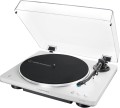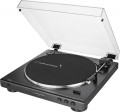Model
Model of the pickup (cartridge) supplied with the player. The pickup is one of the most important parts of any vinyl player, the quality of the received sound largely depends on its quality. Knowing the name of the model, you can find detailed data on it and determine how satisfied you are with this particular cartridge.
Output level
The signal level at the output of the pickup supplied with the player is, in fact, the power of the signal coming from the pickup to the phono stage. This parameter is necessary, first of all, in cases where the player is planned to be connected to an external phono stage: such equipment must be designed for the corresponding power of the signal coming from the pickup.
Downforce
The force of pressing the needle on the plate, which the complete pickup (cartridge) is designed for.
This force depends on the rigidity (compliance) of the needle: the greater the clamping force, the harder the cartridge, respectively, the less pliable it is. It is also believed that less pressing force wears out the record less, but it cannot be said that "light" cartridges are definitely better — there are many other nuances. So in fact, information about the pressing force of a complete pickup is needed mainly in case of its replacement. Usually, the pressing force provided by the arm of the turntable is regulated within these limits, so the new cartridge must also be rated for the same values of downforce — otherwise there is a chance that the turntable will not be able to correctly align.
Tonearm effective length
The effective length of a tonearm in set is the distance from the attachment point (axis of rotation) to the stylus.
This indicator is important primarily for rotary tonearms: the longer the length, the lower the angular error, the smaller the discrepancy between the direction of movement of the track and the longitudinal axis of the pickup (for more details, see “Type”) and the lower the level of corresponding distortion. In addition, a longer length reduces the resonant frequency and reduces the likelihood of distortion. On the other hand, a longer tonearm turns out to be heavier, which requires certain technical tricks and can also negatively affect the purity of the sound. Therefore, a large length is not always a guarantee of high quality – you should also pay attention to weight (see below).
Connection
—
USB B port. A connector designed to connect the player to a computer as a peripheral device. This connection is mainly used for converting vinyl records to a digital audio format such as MP3. At the same time, computer processing allows you to "clean" the recording from clicks and other extraneous interference; the necessary software for this may even be supplied in the kit.
—
Bluetooth. The presence of a built-in Bluetooth module in the design of the player. This technology is designed for direct wireless communication with other devices at a distance of up to 10 m. The capabilities of such communication may vary, depending on the supported Bluetooth protocols. The most popular use of this feature in players is to broadcast audio to wireless headphones or speakers. Such a connection may be somewhat inferior to a wired one in terms of sound quality, but it does not require fiddling with cables and selecting compatible connectors; and the difference in quality is most often unprincipled, especially considering the characteristics of the sound from vinyl. Other options for using Bluetooth are technically possible — for example, remote control from a smartphone or tablet — but they are extremely rare.
—
Audio input. The presence of an audio input in the design of the player; usually in this case it means a linear analogue audio input. In different model
...s, it can use different types of connectors — for example, 3.5 mm mini-Jack or RCA "tulips". However, regardless of the type of connector, the purpose of such an input is the same everywhere — it is designed to connect an external sound source and process this sound with the player's built-in tools. For example, you can connect a portable player to the audio input and output sound through the built-in turntable amplifier.
— Digital audio output. The presence of a digital audio output in the design of the player. Usually, this output is made in the form of an S / P-DIF connector — optical or electronic; the first option is less susceptible to interference, the second does not require special delicacy when handling the cable. This connector can be useful for connecting external audio devices with digital inputs to the player. In some cases, a digital connection is preferable to an analogue one — for example, if there are no line inputs in an external device or they are all occupied. At the same time, the digital interface requires an analogue-to-digital converter in the "turntable", and these are additional electronic circuits and a potential source of interference. Therefore, such outputs are not used in audiophile-class equipment.
— Headphone output. The presence of a separate headphone output in the design of the player. Typically, this output uses a 3.5 mm mini-Jack or 6.35 mm Jack. The first variety is found in most modern headphones, the second is more reliable and typical for professional models; both interfaces are compatible through a simple adapter. Anyway, connecting headphones can come in handy in two situations: when it is desirable to keep silence and not disturb others with music, or vice versa, when it is noisy around and the sound from the speakers would be hard to hear. Theoretically, the second use case is popular among DJs — in the overall sound, it is important to hear what exactly the turntable is playing at the moment. However, in fact, DJs prefer to connect their "ears" not to the player itself, but to external equipment. Therefore, its own headphone output is typical mainly for consumer-class models.Signal to noise ratio
The ratio between the useful signal and extraneous noise at the output of the player. It is also colloquially called "electrical noise" (although this is not entirely true).
The higher this indicator, the quieter the noise (it is impossible to completely eliminate them), the clearer the signal will be. In the case of turntables, the signal-to-noise ratio is considered to be at least 50 dB; and in the most high-end devices it can exceed 90 dB.
Note that this paragraph may additionally indicate the value of mechanical noise. Despite the similarity in name, this is a completely different indicator — it describes the volume of extraneous sounds produced by the motor, drive and other moving parts of the "turntable". Accordingly, for mechanical noise, the lower the decibels, the better. You can estimate its approximate level using special comparative tables.
Power consumption
Rated power consumed by the player during normal operation.
Modern turntables are very economical: most models, even those equipped with built-in acoustics (see "Features"), the power consumption does not exceed 15 W, and there is no need to talk about any serious impact on congestion in the electrical networks (as well as electricity bills). The exception is some premium-class devices, in which the weight of the platter (see below) reaches several tens of kilograms, and the corresponding engine power is required to rotate such a mass.

